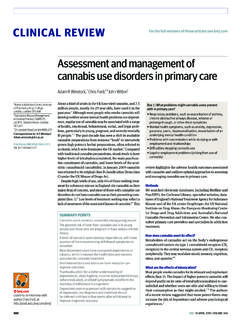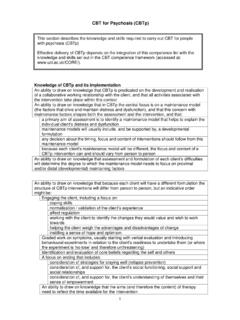Transcription of ACT for Life - Eric Morris, PhD
1 act for life Group Intervention for Psychosis Manual December 2011. Authors: Joseph Oliver, Eric Morris, Louise Johns, & Majella Byrne South London and Maudsley NHS Foundation Trust/. Institute of Psychiatry, King's College London United Kingdom Contact: Special thanks to our colleagues who have helped us in developing this manual: Gordon Mitchell, Amy MacArthur and Ross White 1. Contents 1. Group Rational and Purpose 2. ACT for Psychosis Methods 3. Core Clinical Processes in ACT. 4. Session 1 outline 5. Session 2 outline 6. Session 3 outline 7. Session 4 outline 8. Appendices ACT or Psychosis Adherence Scale 9. Appendices ACT prescribed and proscribed behaviours 10. Appendices - Worksheets 2. Group Rationale and Purpose Many people recovering from psychosis find it difficult to initiate and persevere with actions in important life areas.
2 ACT is consistent with recovery and well-being, providing a set of evidence-based principles. The ACT therapeutic approach to psychosis focuses on helping clients to increase psychological flexibility in order to pursue life goals and directions that are personally meaningful. ACT assumes that psychological flexibility can be developed even when people experience persisting psychotic symptoms. This manual provides a description for a four session group based intervention for people who are experiencing or recovering from distressing psychosis. This intervention is currently being evaluated as part of a research trial, supported by a Guys and St Thomas' Charity Grant. 1. An ACT view of psychosis ACT formulates the problems of distressing psychosis in terms of psychological inflexibility, where individuals experience diminished life circumstances due to excesses of experiential avoidance, over-literality about private experiences, lack of clarity and/or resignation about life directions, and difficulty with committing to actions that are effective over the longer term.
3 The approach of ACT encourages clients to shift agendas from experience elimination and control to pursuing greater life vitality. In terms of coping with psychotic symptoms, ACT encourages a shift from entanglement with anomalous experiences, to orientating behaviour toward chosen values (even in the presence of anomalous experiences). The ACT model posits that people who are distressed and disabled by psychotic symptoms are likely to be living in aversive, escape-based contexts for their behaviour. It is theorised that these contexts are largely verbally regulated (Hayes, Strosahl &. Wilson, 1999). ACT helps the client to access approach-based contexts through an experiential therapeutic approach that uses a set of inter-related processes (see below for the hexaflex ACT model). The ACT stance with distressing psychosis: a. Focusing on symptom impact - Exploring the effects of cognitive fusion and experiential avoidance with delusions and hallucinations b.
4 The experience (in the case of voices), or the feared outcomes of it (delusions), are targets for avoidance and control, thereby increasing symptom impact c. Negative symptoms may be considered a possible outcome of chronic avoidance (limited social reinforcement). d. Emphasising acceptance rather than disputation e. Pragmatic truth criterion: focused on moving things forward, rather than finding the cause of psychotic symptoms f. Targets symptoms indirectly by altering the context within which they are experienced rather than frequency and believability per se. 3. Core Clinical Processes of Acceptance and Commitment Therapy In ACT six processes have been identified as central to the ability to persist or change in the service of valued action, and collectively define the intervention model (Hayes, et al, 2004). These core processes are based on a consistent theory of the functional properties of human language and cognition (Hayes, Barnes-Holmes & Roche, 2001).
5 Figure 1 below shows the relationships that these core processes have with each other and the goal of greater psychological flexibility. Acceptance & Contact with the Mindfulness Commitment &. Present Moment Processes Behaviour Change Processes Acceptance Values Psychological Flexibility Defusion Committed Action Self as Context Figure 1: ACT Hexaflex (Hayes et al, 2004). A description (from Strosahl et al, 2004) of each of these clinical processes is as follows: Acceptance Foster acceptance and willingness while undermining the dominance of emotional control and avoidance in the client's response hierarchy Defusion Undermine the language-based processes that promote fusion, needless reason-giving, and unhelpful evaluation and thus cause private experiences to function as psychological barriers to life -promoting activities Contact with Present Live more in the present moment.
6 Contacting more fully the Moment ongoing flow of experience as it occurs Self-as-Context Make experiential contact with the distinction between self-as- context versus the conceptualised self to provide a position from which acceptance of private events is less threatening Values Identify valued outcomes in living that will legitimise confronting previously avoided psychological barriers Committed Action Build larger and larger patterns of committed action that are consistent with valued life ends 4. There are several principles in the delivery of these clinical processes (Hayes et al., 2004): a. The processes are highly interdependent, so that starting to use one process is likely to see the emergence of other processes. Thus there is no correct order for doing these processes. b. Clients will exhibit idiosyncratic profiles within these processes, so that not all the processes will need to be worked on in therapy.
7 C. Therapists need to be highly proficient at providing interventions within any of the core processes, and avoiding using a one size fits all . approach with regard to sequencing and form of interventions. d. Many ACT interventions touch upon multiple processes, and as therapy is contextualistic the meaning of the intervention is dependent upon the client's unique history and life situation. 5. ACT with Psychosis Methods 1. Key elements: a. Informed Consent b. Normalise psychotic symptoms & introduce observing private events (including voices) as EXPERIENCES. Broaden to contrast between having experiences and responding to them; difference between experience and action. c. Contrast experience of symptoms with responses to them, linking with workability and the function of coping methods d. Suggest acceptance and defusion (willingness/ observing/ describing experiences) as an alternate stance to (resisting/ being entangled in/ judging these experiences).
8 E. Experientially contact a sense of self as perspective (self as observing and containing experiences, but not the content of these experiences). f. Suggest personal values as providing direction in action, contrast with cost of experiential avoidance and fusion with experiences g. Develop step by step and progressive plans to engage in valued actions; review regularly, encouraging use of skills in acceptance, present focus, and defusion to persist or change plans as needed. 2. Where ACT fits as a CBT Approach with Psychosis ACT is a contextual cognitive behavioural therapy approach, based upon behaviour analytic view of cognition. It uses techniques and methods taken from traditional behavioural therapy, as well as from a set of principles from a treatment model that is based upon understanding behaviour in terms of rule governance, relational frame theory and functional contextualism.
9 ACT emphasises acceptance of psychological experience as experience, and noticing the present moment and choices. It can be argued that CBT for Psychosis involves components of acceptance, decentring from experience, and values-focused behaviour change. In CBT for psychosis therapists create the context for change by: - Displaying willingness and acceptance - Reinforcing discussion of experiences (exposure?). - Allowing defusion through distancing (reformulation, floating alternatives, using the cognitive model in a functional way). - Avoiding trap of being overly literal about beliefs (ie, not colluding but also not demanding belief change). - Encouraging behaviour change even if psychotic symptoms persist (values/. behavioural regulation). 3. Why an experiential rather than a direct instruction/sense making approach? The ACT model considers the effects of rule-governance (Hayes, 1989) in contributing to narrow repertoires of behaviour.
10 It is predicted that broad, flexible responding to private experiences and life events is more likely to occur when behaviour is contingency-shaped, rather than rule-governed. 6. ACT targets several types of rule-governed behaviour that are theorised to contribute to client problems (pliance, tracking and augmenting: see Hayes, Wilson & Strosahl, 1999 for a discussion). Therapy can be considered a social context where behaviour is shaped, and new rules are developed. In ACT terms it is important that new behavioural repertoires are developed that will generalise, be flexible to contextual changes, and not require the ongoing presence of the therapist for maintenance. Thus, the aim is for ACT to provide a context where contingency shaped learning occurs (rather than more rule-following): such a context is experientially- and pragmatically-focused, and non-literal in style.






